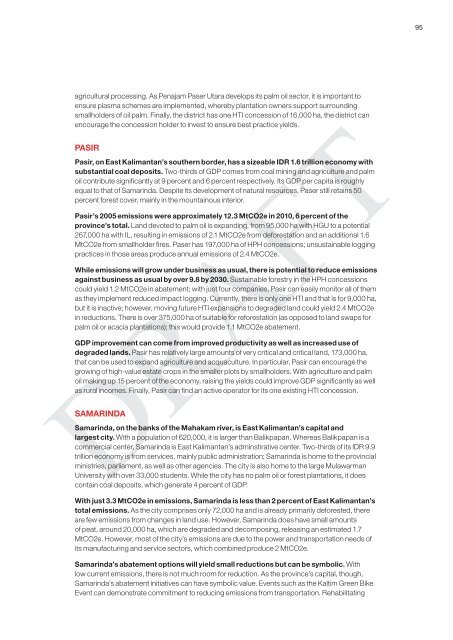East Kalimantan Environmentally Sustainable Development Strategy
East Kalimantan Environmentally Sustainable Development Strategy
East Kalimantan Environmentally Sustainable Development Strategy
Create successful ePaper yourself
Turn your PDF publications into a flip-book with our unique Google optimized e-Paper software.
95<br />
agricultural processing. As Penajam Paser Utara develops its palm oil sector, it is important to<br />
ensure plasma schemes are implemented, whereby plantation owners support surrounding<br />
smallholders of oil palm. Finally, the district has one HTI concession of 16,000 ha, the district can<br />
encourage the concession holder to invest to ensure best practice yields.<br />
PASIR<br />
Pasir, on <strong>East</strong> <strong>Kalimantan</strong>’s southern border, has a sizeable IDR 1.6 trillion economy with<br />
substantial coal deposits. Two-thirds of GDP comes from coal mining and agriculture and palm<br />
oil contribute significantly at 9 percent and 6 percent respectively. Its GDP per capita is roughly<br />
equal to that of Samarinda. Despite its development of natural resources, Paser still retains 50<br />
percent forest cover, mainly in the mountainous interior.<br />
Pasir’s 2005 emissions were approximately 12.3 MtCO2e in 2010, 6 percent of the<br />
province’s total. Land devoted to palm oil is expanding, from 95,000 ha with HGU to a potential<br />
267,000 ha with IL, resulting in emissions of 2.1 MtCO2e from deforestation and an additional 1.6<br />
MtCO2e from smallholder fires. Paser has 197,000 ha of HPH concessions; unsustainable logging<br />
practices in those areas produce annual emissions of 2.4 MtCO2e.<br />
While emissions will grow under business as usual, there is potential to reduce emissions<br />
against business as usual by over 9.8 by 2030. <strong>Sustainable</strong> forestry in the HPH concessions<br />
could yield 1.2 MtCO2e in abatement; with just four companies, Pasir can easily monitor all of them<br />
as they implement reduced impact logging. Currently, there is only one HTI and that is for 9,000 ha,<br />
but it is inactive; however, moving future HTI expansions to degraded land could yield 2.4 MtCO2e<br />
in reductions. There is over 375,000 ha of suitable for reforestation (as opposed to land swaps for<br />
palm oil or acacia plantations); this would provide 1.1 MtCO2e abatement.<br />
GDP improvement can come from improved productivity as well as increased use of<br />
degraded lands. Pasir has relatively large amounts of very critical and critical land, 173,000 ha,<br />
that can be used to expand agriculture and acquaculture. In particular, Pasir can encourage the<br />
growing of high-value estate crops in the smaller plots by smallholders. With agriculture and palm<br />
oil making up 15 percent of the economy, raising the yields could improve GDP significantly as well<br />
as rural incomes. Finally, Pasir can find an active operator for its one existing HTI concession.<br />
SAMARINDA<br />
DRAFT<br />
Samarinda, on the banks of the Mahakam river, is <strong>East</strong> <strong>Kalimantan</strong>’s capital and<br />
largest city. With a population of 620,000, it is larger than Balikpapan. Whereas Balikpapan is a<br />
commercial center, Samarinda is <strong>East</strong> <strong>Kalimantan</strong>’s adminstirative center. Two-thirds of its IDR 9.9<br />
trillion economy is from services, mainly public administration; Samarinda is home to the provincial<br />
ministries, parliament, as well as other agencies. The city is also home to the large Mulawarman<br />
University with over 33,000 students. While the city has no palm oil or forest plantations, it does<br />
contain coal deposits, which generate 4 percent of GDP.<br />
With just 3.3 MtCO2e in emissions, Samarinda is less than 2 percent of <strong>East</strong> <strong>Kalimantan</strong>’s<br />
total emissions. As the city comprises only 72,000 ha and is already primarily deforested, there<br />
are few emissions from changes in land use. However, Samarinda does have small amounts<br />
of peat, around 20,000 ha, which are degraded and decomposing, releasing an estimated 1.7<br />
MtCO2e. However, most of the city’s emissions are due to the power and transportation needs of<br />
its manufacturing and service sectors, which combined produce 2 MtCO2e.<br />
Samarinda’s abatement options will yield small reductions but can be symbolic. With<br />
low current emissions, there is not much room for reduction. As the province’s capital, though,<br />
Samarinda’s abatement initiatives can have symbolic value. Events such as the Kaltim Green Bike<br />
Event can demonstrate commitment to reducing emissions from transportation. Rehabilitating

















